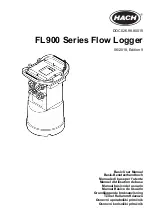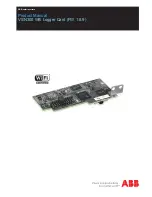
Manual revision 041
Section 2: Description of MicroCAT
SBE 37-SM RS-232
14
Sample Timing
Sample timing is dependent on several factors, including sampling mode and
whether the MicroCAT has an optional pressure sensor.
Autonomous Sampling
(time between samples =
SampleInterval
)
Power on time for each sample while logging:
Without pressure
: power-on time = 1.8 seconds
With pressure
: power-on time = 2.4 seconds
Polled Sampling or Serial Line Sync Sampling
Time from end of take sample command to beginning of reply:
Without pressure
: power-on time = 2.0 seconds
With pressure
: power-on time = 2.6 seconds
Battery Pack Endurance
The battery pack (4 cells in series, 3 parallel strings) has a nominal capacity of
7.8 Amp-hours (2.6 Amp-hours * 3). For planning purposes, to account for the
MicroCAT’s current consumption patterns and for environmental conditions
affecting cell performance,
Sea-Bird recommends using a conservative
value of 6.0 Amp-hours
.
Acquisition current varies, depending on whether the MicroCAT is
transmitting real-time data: 15 mA if transmitting real-time data,
13 mA if not. Quiescent current is 30 microAmps (0.26 AH per year).
Acquisition time is shown above in
Sample Timing
. The time required for each
sample is dependent on the user-programmed sampling mode, and inclusion of
a pressure sensor in the MicroCAT. So, battery pack endurance is highly
dependent on the application. An example is shown below.
You can use the
Deployment Endurance Calculator
to determine the maximum deployment
length, instead of performing the calculations by hand.
Notes:
If the MicroCAT is logging data and
the battery pack voltage is less than
7.1 volts for five consecutive scans,
the MicroCAT halts logging.
Sea-Bird recommends using the
capacity value of 6.0 Amp-hours for
the Saft cells as well as the alternate
cell types (Tadiran TL-4903 and
Electrochem 3B0064/BCX85 AA).
This MicroCAT uses a battery pack
with a
yellow
cover plate. Older
SBE 37-SM MicroCATs use a
battery pack with a red cover plate;
those packs are wired differently,
and will not work properly in this
MicroCAT.
See Specifications above for data
storage limitations.
Example:
A MicroCAT with pressure sensor is set up to sample autonomously every 10 minutes (6 samples/hour), and
is not transmitting real-time data. How long can it be deployed?
Sampling
time (autonomous sampling, with pressure sensor) = 2.4 seconds
Sampling current consumption = 0.013 Amps * 2.4 seconds = 0.031 Amp-seconds/sample
In 1 hour, sampling current consumption = 6 * 0.031 Amp-seconds/sample =
0.19 Amp-seconds/hour
Quiescent
current = 30 microAmps = 0.03 mA
In 1 hour, quiescent current consumption ≈ 0.03 mA * 3600 seconds/hour =
0.11 Amp-seconds/hour
Total
current consumption / hour = 0.19 + 0.11 =
0.3 Amp-seconds/hour
Capacity = (8.8 Amp-hours * 3600 seconds/hr) / (0.3 Amp-seconds/hour) = 105,000 hours = 4400 days = 12 years!
However, Sea-Bird recommends that batteries should not be expected to last longer than 2 years in the field.
Number of samples = 105,000 hours * 6 samples/hour = 630,000 samples
Notes:
Acquisition time shown does not
include time to transmit real-time
data, which is dependent on baud
rate (
BaudRate=
) and number of
characters being transmitted
(defined by
OutputFormat=
,
OutputSal=
, and
OutputSV=
).
Time stored and output with the data
is the time at the
start
of the
sample, after a small amount of time
for the MicroCAT to wake up and
prepare to sample. For example, if
the MicroCAT is programmed to
wake up and sample at 12:00:00,
the stored and displayed time will
indicate 12:00:01 or 12:00:02.















































